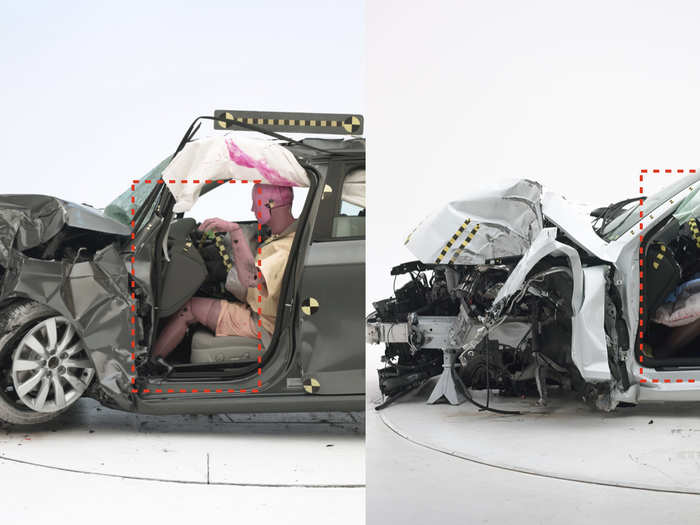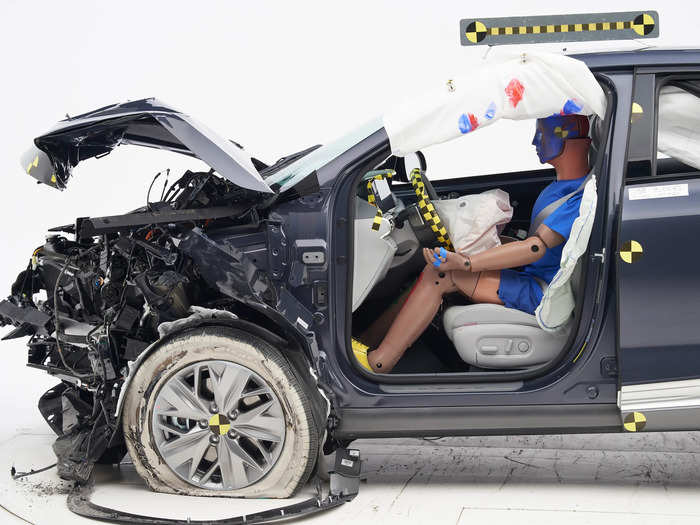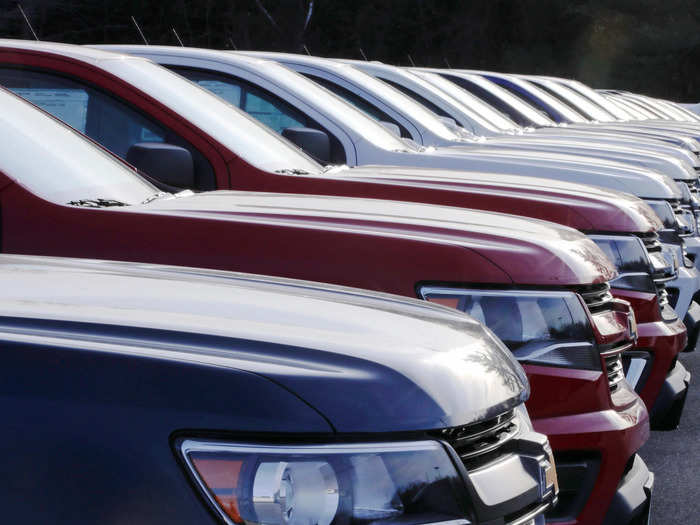- Home
- slideshows
- miscellaneous
- Trump rolled back fuel-economy standards in the US this week to make vehicles 'substantially safer,' but his claims about car safety don't mesh with reality
Trump rolled back fuel-economy standards in the US this week to make vehicles 'substantially safer,' but his claims about car safety don't mesh with reality
CLAIM 1: Making cars "substantially safer"

Trump rolled back fuel-economy standards in the US this week to make vehicles 'substantially safer,' but his claims about car safety don't mesh with reality

That can be seen in IIHS aftermath photos, such as the ones for the Audi A4. The 2012 model shows a dashboard scrunched in on the dummy driver, hitting its legs and moving its arms out of place.
By the 2017 model year, after the A4 was completely redesigned, it had a far stronger barrier between the driver and the impact point, leaving the dummy's legs and arms with room to move. Those improvements occurred even amid tightened efficiency regulations.
As automakers have generally gotten driver's-side crash safety under control, IIHS introduced the same test on the passenger side a few years ago. Poor results were, again, aplenty — as shown by the differences in occupant protection between the driver and passenger sides in the 2015 Toyota RAV4, which had the highest rating on the driver side and the lowest on the passenger side.
Trump rolled back fuel-economy standards in the US this week to make vehicles 'substantially safer,' but his claims about car safety don't mesh with reality

That's now changing, too, even if automakers can often be more reactive than proactive when it comes to new crash and safety tests.
Still, those reactions have been able to occur since 2012, because stricter fuel-economy regulations haven't led to a pullback on safety improvements. Neither has the introduction of greener power.
CLAIM 2: Fuel-efficient cars are like "papier-mâché" in crashes

Last year, CNN reporter Daniel Dale quoted Trump as saying that cars "have so much junk on them now to save a tiny little fraction of gasoline," while calling himself an "environmentalist." Trump went on to say that fuel-efficient cars are made out of "papier-mâché," and that heavier is better when it comes to crashes.
"When somebody hits me, I want to be in as close to an army tank as possible," Trump said.
Size is a factor in crashes, and that's why the IIHS recommends bigger used cars for young drivers. That's how collisions work, and the results of crash tests in the lab are determined by the weight of the vehicle being crashed — thus, IIHS said in a 2018 release, those who go for smaller vehicles "are choosing a lower level of protection" even if that car is an award winner.
Trump rolled back fuel-economy standards in the US this week to make vehicles 'substantially safer,' but his claims about car safety don't mesh with reality

But being a certain weight doesn't guarantee protection in every situation, as shown by the IIHS' famous, decade-old video of a 1959 Chevy Bel Air and a 2009 Chevy Malibu hitting each other head on. Both weighed in the 3,500-pound range, and the Malibu held up well by 2009 standards, while the Bel Air folded in on itself — not because of weight, but because of 50 years of safety improvements.
Many smaller cars are award winners, too. Four models in the IIHS' "small cars" category currently have Top Safety Pick Plus badges, while 14 others got its Top Safety Pick award.
Scroll down to the "large pickups" category, though, and not a single truck got either award. The same goes for the five minivans on file with the IIHS for the 2020 model year.
Trump rolled back fuel-economy standards in the US this week to make vehicles 'substantially safer,' but his claims about car safety don't mesh with reality

Fuel-efficient cars also aren't "papier-mâché," as shown by the crash tests themselves.
Two models that have no gasoline options — the hydrogen-powered Hyundai Nexo and the electric Tesla Model 3 — received the IIHS' highest Top Safety Pick Plus honor, which only 23 different models had earned when the IIHS announced winners earlier this year. The Subaru Crosstrek Hybrid made the list as well.
The Nexo is considered a midsize luxury SUV by the IIHS, and was one of only six in that category to receive an award — five Top Safety Pick Plus winners, and one winner of the slightly lower award Top Safety Pick. There are 19 midsize luxury SUVs on the list, meaning Hyundai's greener offering is in the upper third of its class.
CLAIM 3: Lowering the price of cars for the average consumer

Trump has said his proposal to the "politically correct automobile companies" would "lower the average price of a car to consumers by more than $3,500," which the EPA celebrated in its announcement as "making newer, safer, cleaner vehicles more accessible for Americans who are, on average, driving 12-year-old cars."
"By making newer, safer, and cleaner vehicles more accessible for American families, more lives will be saved and more jobs will be created," the announcement said.
But an IHS Markit study in 2019 found that Americans are driving 12-year-old cars not necessarily because the price of a new one is $3,500 higher than they'd like, but because those more modern vehicles hold up longer than vehicles did in the past. Longer loan periods are also a factor, leading owners to maintain their cars for years and years just to pay them off.
And while newer vehicles are, on average, safer than older ones, purchase price isn't the only factor when it comes to car ownership — the cost of actually owning the car matters, too. That includes monthly payments, insurance, maintenance, and fuel, among other things.
Trump rolled back fuel-economy standards in the US this week to make vehicles 'substantially safer,' but his claims about car safety don't mesh with reality

A 2018 University of Michigan study found the average annual cost of driving a new gasoline vehicle in the US to be $1,117, compared to $485 for an EV. There's a cost difference between more versus less efficient gasoline cars, too, but far less so.
Lowering the price of a new car doesn't automatically open the doors of late-2010s auto safety for everyone, either — the doors are already open by those standards, courtesy of depreciation.
The Hyundai Ioniq Hybrid, for example, got the IIHS' top rating in every crashworthiness category for the 2017 model year, including the passenger-side test that many automakers still struggle with. Low-mileage examples of that car can be found in the $14,000 range, compared to a $23,200 starting price for the 2020 model with the same crashworthiness ratings.
That's a far bigger difference than $3,500.
Trump rolled back fuel-economy standards in the US this week to make vehicles 'substantially safer,' but his claims about car safety don't mesh with reality

That's because affordable safety isn't hard to find if you're looking for it, and choosing efficiency doesn't require forgoing protection. Every vehicle purchase simply calls for a couple of quick searches for safety ratings, which can reveal strengths and weaknesses in all kinds of cars — not just the ones spewing fewer fumes.
Popular Right Now
Popular Keywords
Advertisement